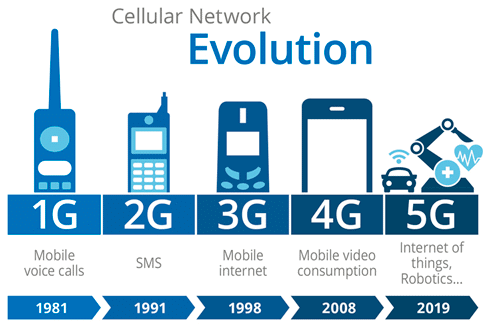5G | Science & Technology for UPSC CSE PDF Download
Introduction to 5G
- 5G is the next generation of mobile broadband that will eventually replace, or at least augment 4G LTE connection.
Features and benefits of the 5G technology
- Operate in the millimeter wave spectrum (30-300 GHz) which have the advantage of sending large amounts of data at very high speeds.
- Operate in 3 bands, namely low, mid and high frequency spectrum.
- Reduced latency will support new applications that leverage the power of 5G, the Internet of Things (IoT), and artificial intelligence.
- Increased capacity on 5G networks can minimize the impact of load spikes, like those that take place during sporting events and news events.
 1G to 5G
1G to 5G
Significance of the Technology
India’s National Digital Communications Policy 2018 highlights the importance of 5G when it states that the convergence of a cluster of revolutionary technologies including 5G, the cloud, Internet of Things (IoT) and data analytics, along with a growing start-up community, promise to accelerate and deepen its digital engagement, opening up a new horizon of opportunities.
What are the potential health risks from 5G?
To date, and after much research performed, no adverse health effect has been causally linked with exposure to wireless technologies.
- Tissue heating is the main mechanism of interaction between radiofrequency fields and the human body. Radiofrequency exposure levels from current technologies result in negligible temperature rise in the human body.
- As the frequency increases, there is less penetration into the body tissues and absorption of the energy becomes more confined to the surface of the body (skin and eye).
Provided that the overall exposure remains below international guidelines, no consequences for public health are anticipated.
What are the international exposure guidelines?
Two international bodies produce exposure guidelines on electromagnetic fields. Many countries currently adhere to the guidelines recommended by:
- The International Commission on Non-Ionizing Radiation Protection.
- The Institute of Electrical and Electronics Engineers, through the International Committee on Electromagnetic Safety.
These guidelines are not technology-specific. They cover radiofrequencies up to 300 GHz, including the frequencies under discussion for 5G.
International efforts- International Electromagnetic Fields (EMF) Project
WHO established the International Electromagnetic Fields (EMF) Project in 1996. The project investigates the health impact of exposure to electric and magnetic fields in the frequency range 0-300 GHz and advises national authorities on EMF radiation protection.
1. Hurdles in Rolling Out 5G Technology
- Enabling critical infrastructures: 5G will require a fundamental change to the core architecture of the communication system. The major flaw of data transfer using 5G is that it can't carry data over longer distances. Hence, even 5G technology needs to be augmented to enable infrastructure.
- Financial liability on consumers: For transition from 4G to 5G technology, one has to upgrade to the latest cellular technology, thereby creating financial liability on consumers.
- Capital Inadequacy: Lack of flow of cash and adequate capital with the suitable telecom companies (like Bharti Airtel and Vodafone Idea) is delaying the 5G spectrum allocation.
2. Utility of 5G Applications: Combined with IoT, cloud, big data, AI, and edge computing, 5G could be a critical enabler of the fourth industrial revolution.
- For India: 5G networks could improve the accessibility of services such as mobile banking and healthcare, and enable exponential growth in opportunities for unemployed or underemployed people to engage in fulfilling and productive work. For this Government has rolled out enabling policies.
3. 5G Enabling Policy
- India’s National Digital Communications Policy 2018 highlights the importance of 5G when it states that the convergence of a cluster of revolutionary technologies including 5G, the cloud, Internet of Things (IoT) and data analytics, along with a growing start-up community, promise to accelerate and deepen its digital engagement, opening up a new horizon of opportunities.
- It aims to reach 100% teledensity, high-speed internet highways and delivery of citizen-centric services electronically.
4. Global Progress on 5G
- Global telecom companies have already started building 5G networks and rolling it out to their customers in many countries:
- 5G had been deployed in 50 cities in the United States.
- South Korea has rolled out 5G to 85 cities.
- Japan and China have too started 5G mobile service on a trial basis.
|
146 videos|358 docs|249 tests
|
FAQs on 5G - Science & Technology for UPSC CSE
| 1. What is 5G technology? |  |
| 2. What are the main advantages of 5G technology? |  |
| 3. How does 5G differ from 4G? |  |
| 4. How will 5G impact various industries? |  |
| 5. Will 5G replace 4G completely? |  |
|
146 videos|358 docs|249 tests
|

|
Explore Courses for UPSC exam
|

|


















